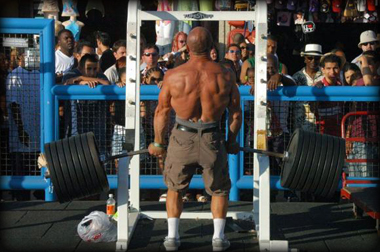Deadlifts for Disc Herniations: Part 3
So to conclude this little min-series on deadlifting and recovering from disc herniations, we’re going to look at some of my favorite methods for working back into a deadlift. If you haven’t checked out parts 1 and 2, you can view them both HERE and HERE respectively.
In the last post, we worked on grooving the hip hinge movement necessary for deadlifting, and increased the requirements on the lumbar spine to maintain neutral while limiting the shear forces involved that would put the disc at an increased risk. Now since we’re going to be placing the spine under load with a deadlift, it will be very important to make sure positioning and technique are absolutely bulletproof to make sure the spine is exposed to a limited amount of shear forces.
Deadlift Progressions
There is a simple progression I like to use with a lot of clients when it comes to learning how to deadlift, beginning with a single-arm dumbell deadlift, moving into sumo rack pulls, then to sumo pulls from the floor, to conventional rack pulls, to conventional floor pulls. Aside from adding a shit-load of variety to the deadlifting pattern, or gives some unique advantages by going through this sequence.
1. 1-arm deadlifts allows for some spinal rotation and pelvic rotation to reduce the posterior strain on the lumbar spine, which would increase the pressure on the disc.
2. Teaching sumo lifts allows for a more vertical torso while performing the lift, and allows for a shorter horizontal distance from the bar to the axis of rotation in the lumbar spine, which reduces the amount of torque it’s exposed to.
3. Progressing from rack pulls to floor pulls allows the individual to experience the weight, and work on positioning before putting them into a bigger range of motion that may compromise the spinal mechanics. This also allows them to build up tissue strength of the ligaments, tendons and muscles before putting them on the floor, which will limit the chances of injury.
Exercise 1: 1-arm Dumbell Deadlift
Coupling a wider stance with a resistance that’s closer to the axis of rotation limits shear and torque, and by allowing some rotation it reduces the strain on the spine while forcing the hips to work harder than a typical deadlift.
Exercise 2: Sumo Rack Pulls
This can allow for more substantial loads than with a dumbell, and the racks can allow for a greater load without risking a larger range of motion which might compromise spinal mechanics at this stage.
Exercise 3: Sumo from the floor
Cutting the weight used in a rack pull to 60% of what was used, begin to lift from the floor and work on maintaining spinal mechanics throughout the movement. Try not to do what Mark does here, though.
Exercise 4: Conventional Rack Pulls
Since conventional pulls place more strain on the spine than sumo deadlifts, it should always be started with less than full range of motion in order to groove the pattern and to ensure the mechanics are correct. Skipping to floor pulls can typically result in sloppy mechanics, and a new tweak to the disc, which I’ve experienced first-hand a few times in my journey. In addition to being scary as hell, these little tweaks tend to decrease abdominal and pelvic muscle recruitment which doesn’t bode well for getting your swole on. Rack pulls help to reduce the chances of this happening. Load the bar with the same weight you were using for the sumos, and give it a whirl.
Depending on how low your racks go, you may find that they may be set too high. A simple fix for this would be to put a riser of some kind on the floor. I’ve seen everything from the Reebok steps to a 2×6 piece of wood used, but essentially anything that’s stable enough to stand on and give you a few inches would work well here. Aside from that, strap your feet to the bar and hang upside down and grow, dammit!!
Exercise 5: Conventional Floor Pulls
Normally, it will take about 2-3 months of consistent work to be able to even get close to this stage following any discogenic injury, so take your time and build into it. Conservative estimates say that most disc injuries that don’t require surgery will resolve on their own within six months, and depending on the surgical protocol it could be a few weeks to a few years to see resolution, so don’t rush the process and hope to pull off the floor too soon. Work through a progression of logical steps and you’ll be able to ensure you have the right mechanics, the required strength and mobility, and the confidence to be able to handle a pull from the floor like this.
As I’ve said before, this is in no way meant to impress anyone with the amount of weight lifted, because there are waaaaaay stronger dudes out there than me, especially at my current body weight of 235 (that works out to a pull of 1.72 times body weight, when there are guys pulling 3+ times their weight). It’s a personal victory over a long-standing injury, and hopefully an inspiration to others who have gone through similar injuries and instances of pain that it can be overcome with the right training program and a good attitude towards it.

4 Responses to Deadlifts for Disc Herniations: Part 3